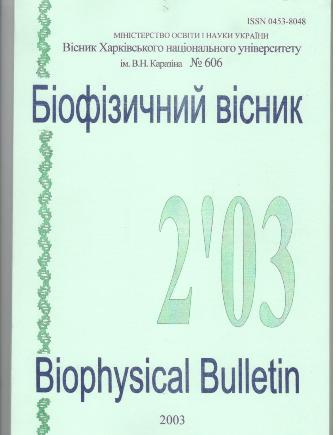Physical interpretation of passive mass transfer coefficients as friction coefficients
Abstract
To interpret results on passive transmembrane mass transfer one utilize often the relationships between standard transport characteristics of biological membranes and coefficients of reciprocal friction between separate components of a system. In contrast to Kedem and Katchalsky, obtained the correlation between transport characteristics of biological membranes and friction coefficients when considering the one-dimensional diffusion via plane unbounded immobile separately permeable membrane, this work presents the firstly obtained analogous correlation for the case of closed mobile separately permeable membrane of unrestricted shape, that reflects more adequately the real state when studying the processes of mass transfer via cell membranes.
Downloads
References
Sha’afi RI, Rich GT, Mikulecy DC, Solomon AK. Determination of urea permeability in red cell by minimum method. J. Gen. Physiol. 1970;55:427-50.
Owen JD, Eyring EM. Reflection coefficients of permeant molecules in human red cell suspensions. J. Gen. Physiol. 1975;66:251-65.
Macey RL. Permeability of red cells to water and non-electrolytes. Transport across biological membranes. V.2-N-Y:Springer-Verlag; 1979. P.1-57.
Levitt DG, Mlekoday HJ. Reflection coefficient and permeability of urea and ethylenglycol in the human red cell membrane. J. Gen. Physiol. 1983;81:239-54.
Toon MR, Solomon AK. Transport parameters in the human red cell membrane: solute-membrane interaction of hydrophilic alcohols and their effect on permeation. BBA. 1990;1022:57-71.
Toon MR, Solomon AK. Permeability and reflection coefficients of urea and small amides in human red cell. J. Membr. Boil. 1996;153:137-46.
Gordijenko OI, Gordijenko JeO. Dzherelo entropii' i rivniannia rukhu bagatokomponentnogo rozchinu. Biofizichnii visnik. 2003;1(12):74-8. (in Ukrainian)
Diarmati I. Neravnoveseaia termodinamika teoriia polia i variatcionnye printcipy. M.:Mir; 1974. 304p. (in Russian)
Kedem O, Katchalsky A. A physical interpretation of the phenomenological coefficients of membrane permeability. J. Gen. Physiol. 1961;45:143-79.
Authors who publish with this journal agree to the following terms:
- Authors retain copyright and grant the journal right of first publication with the work simultaneously licensed under a Creative Commons Attribution License that allows others to share the work with an acknowledgement of the work's authorship and initial publication in this journal.
- Authors are able to enter into separate, additional contractual arrangements for the non-exclusive distribution of the journal's published version of the work (e.g., post it to an institutional repository or publish it in a book), with an acknowledgement of its initial publication in this journal.
- Authors are permitted and encouraged to post their work online (e.g., in institutional repositories or on their website) prior to and during the submission process, as it can lead to productive exchanges, as well as earlier and greater citation of published work (See The Effect of Open Access).





